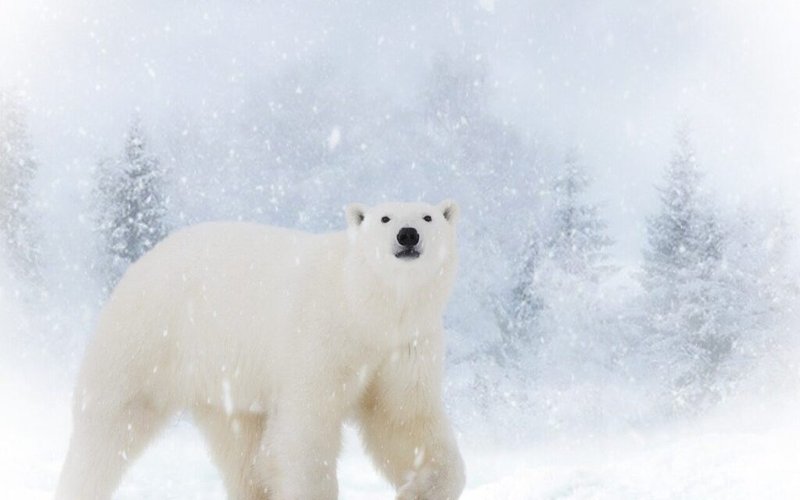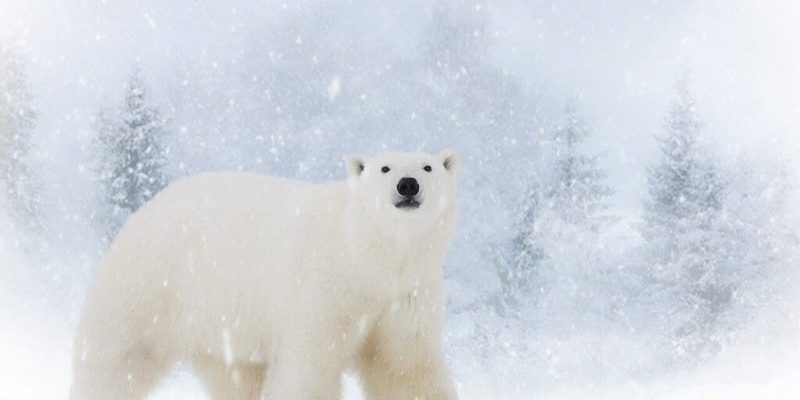
In this article, we’ll unravel those common myths surrounding polar bears and shed light on the truths behind them. You’ll learn things like their habitat, diet, and behavior that might surprise you. So grab your favorite drink, and let’s break it down together!
Myth 1: Polar Bears Are Purely White
One of the most popular misconceptions about polar bears is that they are purely white. Sure, when you see a polar bear on ice, it looks like a big fluffy snowball. But here’s the thing: polar bear fur is actually transparent and hollow. It reflects visible light, which is why they appear white.
This trait helps them blend into their icy surroundings, making it easier for them to hunt. But during the summer months or when they’re on land, polar bears can appear a bit darker due to dirt or algae in their fur. This camouflage is crucial for their survival, showing just how perfectly adapted they are to their environment.
Beyond just their fur, their skin is also black. How cool is that? The black skin helps absorb heat from the sun, which is especially important in the cold Arctic climate. So, the next time you think of a polar bear, remember it’s not just about their fluffy white appearance.
Myth 2: Polar Bears Only Eat Seals
Another common belief is that polar bears eat only seals. You might picture them patiently waiting by a hole in the ice, ready to snatch one out of the water. While seals do make up a significant part of their diet—about 90%—they are opportunistic eaters. This means they’ll munch on a variety of foods, depending on what’s available.
In addition to seals, polar bears will eat other marine mammals, bird eggs, and even vegetation like berries when the opportunity arises. In fact, they’ve been known to scavenge on carcasses too. This adaptability is key for their survival, especially as climate change alters their habitat and affects access to food.
So, while seals are indeed a polar bear’s favorite snack, they aren’t picky eaters. This flexibility helps them thrive in one of the harshest environments on Earth.
Myth 3: Polar Bears Are Dangerous to Humans
You might think polar bears are dangerous and aggressive animals, ready to charge at the first human they see. Here’s the truth: while they certainly have the capability to cause harm, polar bears are generally not the mindless killers they’re sometimes made out to be.
Most polar bear encounters occur in areas where humans and bears overlap, usually in search of food. When faced with humans, polar bears are often more curious than aggressive. They prefer to avoid conflict. Interestingly, most attacks on humans are a result of surprise or self-defense when a bear feels threatened.
If you’re lucky enough to observe a polar bear in the wild, it’s essential to respect their space and keep a safe distance. They’re magnificent creatures, and watching them from afar is far safer for both parties!
Myth 4: All Polar Bears Are the Same Size
You might picture all polar bears as enormous, towering beasts, but that’s another misconception. Polar bears actually come in various sizes. Adult males typically weigh between 900 to 1,600 pounds, while females are generally smaller, weighing about 330 to 650 pounds.
Size can also vary based on location and food availability. For instance, polar bears on the edge of the Arctic may be smaller compared to those with abundant food sources. Additionally, age and health play vital roles in determining a bear’s size. It’s a delicate balance of genetics, environment, and food resources.
So, while we often think of polar bears as giants, their sizes can vary quite a bit, lending more complexity to their nature.
Myth 5: Polar Bears Are Not Endangered
Many people believe that polar bears are thriving in their Arctic home. However, this couldn’t be further from the truth. Polar bears are classified as vulnerable by the International Union for Conservation of Nature (IUCN). This status is largely a result of climate change and the loss of sea ice, which is critical for their hunting and breeding.
As the ice melts due to rising temperatures, polar bears struggle to find food and, ultimately, to survive. Their habitat is shrinking, making it harder for them to roam and find seals. Conservation efforts are ongoing, but they depend heavily on global cooperation to combat climate change.
You might be wondering what we, as individuals, can do to help. Simple actions like reducing our carbon footprint or supporting environmental organizations can contribute to the fight against climate change. Every little bit helps!
Myth 6: Polar Bears Hibernate Like Other Bears
If you think polar bears hibernate like black or grizzly bears, you’re in for a surprise. While some bears enter a state of dormancy during the winter to conserve energy, polar bears don’t truly hibernate. Instead, they are quite active throughout the year.
Pregnant polar bears are the exception—they’ll den up for a few months to give birth and nurse their cubs. But for most adult bears, they stay alert and vigilant in their search for food, even in harsh winter conditions. This steady activity is essential for maintaining their strength and health in such a relentless environment.
So, while you might imagine a fat, sleepy bear in a cozy cave, polar bear behavior is much more dynamic and suited to their icy home.
Polar bears are amazing animals, rich with myths and misconceptions that can cloud our understanding of their lives. From their unique adaptations and dietary habits to their behavior and the threats they face, there’s so much more to these creatures than meets the eye.
By clearing up these common myths, we can appreciate polar bears for the complex beings they are and understand what’s at stake for their future. As their habitat continues to change, it’s vital to champion efforts that protect them. Next time you think of polar bears, I hope you remember their resilience, adaptability, and the importance of conserving their world. Every little effort counts when it comes to protecting these incredible animals and the Arctic ecosystem they represent!

